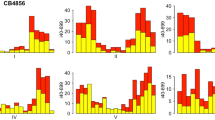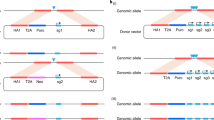Abstract
Transposons have been enormously useful for genetic analysis in both Drosophila and bacteria. Mutagenic insertions constitute molecular tags that are used to rapidly clone the mutated gene. Such techniques would be especially advantageous in the nematode Caenorhabditis elegans, as the entire sequence of the genome has been determined. Several different types of endogenous transposons are present in C. elegans, and these can be mobilized in mutator strains (reviewed in ref. 1). Unfortunately, use of these native transposons for regulated transposition in C. elegans is limited. First, all strains contain multiple copies of these transposons and thus new insertions do not provide unique tags. Second, mutator strains tend to activate the transposition of several classes of transposons, so that the type of transposon associated with a particular mutation is not known. Here we demonstrate that the Drosophila mariner element Mos1 can be mobilized in C. elegans. First, efficient mobilization of Mos1 is possible in somatic cells. Second, heritable insertions of the transposon can be generated in the germ line. Third, genes that have been mutated by insertion can be rapidly identified using inverse polymerase chain reaction. Fourth, these insertions can subsequently be remobilized to generate deletion and frameshift mutations by imperfect excision.
This is a preview of subscription content, access via your institution
Access options
Subscribe to this journal
Receive 51 print issues and online access
$199.00 per year
only $3.90 per issue
Buy this article
- Purchase on Springer Link
- Instant access to full article PDF
Prices may be subject to local taxes which are calculated during checkout



Similar content being viewed by others
References
Plasterk, R. H. A. & van Luenen, H. G. A. M. in C. elegans II (eds Riddle, D. L., Blumenthal, T., Meyer, B. J. & Priess, J. R.) 97–116 (Cold Spring Harbor Laboratory, New York, 1997).
Jacobson, J. W., Medhora, M. M. & Hartl, D. L. Molecular structure of a somatically unstable transposable element in Drosophila. Proc. Natl Acad. Sci. USA 83, 8684–8688 (1986).
Hartl, D. L., Lohe, A. R. & Lozovskaya, E. R. Modern thoughts on an ancyent marinere: function, evolution, regulation. Annu. Rev. Genet. 31, 337–358 (1997).
Plasterk, R. H., Izsvak, Z. & Ivics, Z. Resident aliens: the Tc1/mariner superfamily of transposable elements. Trends Genet. 15, 326–332 (1999).
Tosi, L. R. & Beverley, S. M. cis and trans factors affecting Mos1 mariner evolution and transposition in vitro, and its potential for functional genomics. Nucleic Acids Res. 28, 784–790 (2000).
Gueiros-Filho, F. J. & Beverley, S. M. Trans-kingdom transposition of the Drosophila element mariner within the protozoan Leishmania. Science 276, 1716–1719 (1997).
Coates, C. J., Jasinskiene, N., Miyashiro, L. & James, A. A. Mariner transposition and transformation of the yellow fever mosquito, Aedes aegypti. Proc. Natl Acad. Sci. USA 95, 3748–3751 (1998).
van Luenen, H. G., Colloms, S. D. & Plasterk, R. H. Mobilization of quiet, endogenous Tc3 transposons of Caenorhabditis elegans by forced expression of Tc3 transposase. EMBO J. 12, 2513–2520 (1993).
Gruidl, M. E. et al. Multiple potential germ-line helicases are components of the germ-line- specific P granules of Caenorhabditis elegans. Proc. Natl Acad. Sci. USA 93, 13837–13842 (1996).
Lohe, A. R., Timmons, C., Beerman, I., Lozovskaya, E. R. & Hartl, D. L. Self-inflicted wounds, template-directed gap repair and a recombination hotspot. Effects of the mariner transposase. Genetics 154, 647–656 (2000).
van Luenen, H. G., Colloms, S. D. & Plasterk, R. H. The mechanism of transposition of Tc3 in C. elegans. Cell 79, 293–301 (1994).
The C. elegans Sequencing Consortium. Genome sequence of the nematode C. elegans: a platform for investigating biology. Science 282, 2012–2018 (1998).
Sulston, J. E. & Brenner, S. The DNA of Caenorhabditis elegans. Genetics 77, 95–104 (1974).
Waterston, R. H., Sulston, J. E. & Coulson, A. R. in C. elegans II (eds Riddle, D. L., Blumenthal, T., Meyer, B. J. & Priess, J. R.) 23–45 (Cold Spring Harbor Laboratory, New York, 1997).
Bryan, G., Garza, D. & Hartl, D. Insertion and excision of the transposable element mariner in Drosophila. Genetics 125, 103–114 (1990).
Sedensky, M. M., Hudson, S. J., Everson, B. & Morgan, P. G. Identification of a mariner-like repetitive sequence in C. elegans. Nucleic Acids Res. 22, 1719–1723 (1994).
Robertson, H. M. & Lampe, D. J. Recent horizontal transfer of a mariner transposable element among and between Diptera and Neuroptera. Mol. Biol. Evol. 12, 850–862 (1995).
Medhora, M., Maruyama, K. & Hartl, D. L. Molecular and functional analysis of the mariner mutator element Mos1 in Drosophila. Genetics 128, 311–318 (1991).
Candido, E. P. et al. Structure, organization, and expression of the 16-kDa heat shock gene family of Caenorhabditis elegans. Genome 31, 690–697 (1989).
Clark, S. G., Lu, X. & Horvitz, H. R. The Caenorhabditis elegans locus lin-15, a negative regulator of a tyrosine kinase signaling pathway, encodes two different proteins. Genetics 137, 987–997 (1994).
Kramer, J. M., French, R. P., Park, E. C. & Johnson, J. J. The Caenorhabditis elegans rol-6 gene, which interacts with the sqt-1 collagen gene to determine organismal morphology, encodes a collagen. Mol. Cell. Biol. 10, 2081–2089 (1990).
Kelly, W. G., Xu, S., Montgomery, M. K. & Fire, A. Distinct requirements for somatic and germline expression of a generally expressed Caernorhabditis elegans gene. Genetics 146, 227–238 (1997).
Williams, B. D., Schrank, B., Huynh, C., Shownkeen, R. & Waterston, R. H. A genetic mapping system in Caenorhabditis elegans based on polymorphic sequence-tagged sites. Genetics 131, 609–624 (1992).
Fire, A., Harrison, S. W. & Dixon, D. A modular set of lacZ fusion vectors for studying gene expression in Caenorhabditis elegans. Gene 93, 189–198 (1990).
Acknowledgements
We thank D. Hartl, H. van Leunen, R. Plasterk, S. Beverley and K. Bennett for gifts of DNA constructs, and O. Hobert for unpublished information. We also thank H. Rausch for initial studies using Tc3 and C. Johnston, E. Lyman and M. Miller for screening help. This work was funded by an NSF grant. J.-L.B. was supported by INSERM, EMBO and the Fondation Simone et Cino del Ducca.
Author information
Authors and Affiliations
Corresponding author
Rights and permissions
About this article
Cite this article
Bessereau, JL., Wright, A., Williams, D. et al. Mobilization of a Drosophila transposon in the Caenorhabditis elegans germ line. Nature 413, 70–74 (2001). https://doi.org/10.1038/35092567
Received:
Accepted:
Issue Date:
DOI: https://doi.org/10.1038/35092567
This article is cited by
-
A role for worm cutl-24 in background- and parent-of-origin-dependent ER stress resistance
BMC Genomics (2022)
-
Targeted genome engineering in Caenorhabditis elegans
Cell & Bioscience (2016)
-
Applications of CRISPR–Cas systems in neuroscience
Nature Reviews Neuroscience (2016)
-
Characterization of irritans mariner-like elements in the olive fruit fly Bactrocera oleae (Diptera: Tephritidae): evolutionary implications
The Science of Nature (2016)
-
Random and targeted transgene insertion in Caenorhabditis elegans using a modified Mos1 transposon
Nature Methods (2014)
Comments
By submitting a comment you agree to abide by our Terms and Community Guidelines. If you find something abusive or that does not comply with our terms or guidelines please flag it as inappropriate.



